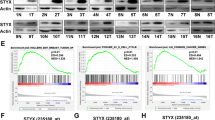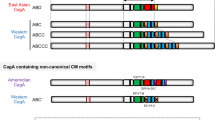Abstract
Chronic infection with cagA-positive Helicobacter pylori is the strongest risk factor for the development of gastric adenocarcinoma. The cagA gene product CagA is injected into gastric epithelial cells and disturbs cellular functions by physically interacting with and deregulating a variety of cellular signaling molecules. RUNX3 is a tumor suppressor in many tissues, and it is frequently inactivated in gastric cancer. In this study, we show that H. pylori infection inactivates the gastric tumor suppressor RUNX3 in a CagA-dependent manner. CagA directly associates with RUNX3 through a specific recognition of the PY motif of RUNX3 by a WW domain of CagA. Deletion of the WW domains of CagA or mutation of the PY motif in RUNX3 abolishes the ability of CagA to induce the ubiquitination and degradation of RUNX3, thereby extinguishing its ability to inhibit the transcriptional activation of RUNX3. Our studies identify RUNX3 as a novel cellular target of H. pylori CagA and also reveal a mechanism by which CagA functions as an oncoprotein by blocking the activity of gastric tumor suppressor RUNX3.
This is a preview of subscription content, access via your institution
Access options
Subscribe to this journal
Receive 50 print issues and online access
$259.00 per year
only $5.18 per issue
Buy this article
- Purchase on Springer Link
- Instant access to full article PDF
Prices may be subject to local taxes which are calculated during checkout




Similar content being viewed by others
References
Blaser MJ, Perez-Perez GI, Kleanthous H, Cover TL, Peek RM, Chyou PH et al. (1995). Infection with Helicobacter pylori strains possessing cagA is associated with an increased risk of developing adenocarcinoma of the stomach. Cancer Res 55: 2111–2115.
Chang TL, Ito K, Ko TK, Liu Q, Salto-Tellez M, Yeoh KG et al. (2009). Claudin-1 has tumor suppressive activity and is a direct target of RUNX3 in gastric epithelial cells. Gastroenterology 138: 255–265.
Chi XZ, Yang JO, Lee KY, Ito K, Sakakura C, Li QL et al. (2005). RUNX3 suppresses gastric epithelial cell growth by inducing p21(WAF1/Cip1) expression in cooperation. Mol Cell Biol 25: 8097–8107.
Franco AT, Israel DA, Washington MK, Krishna U, Fox JG, Rogers AB et al. (2005). Activation of beta-catenin by carcinogenic Helicobacter pylori. Proc Natl Acad Sci USA 102: 10646–10651.
Hanai J, Chen LF, Kanno T, Ohtani-Fujita N, Kim WY, Guo WH et al. (1999). Interaction and functional cooperation of PEBP2/CBF with Smads. Synergistic induction of the immunoglobulin germline Calpha promoter. J Biol Chem 274: 31577–31582.
Hatakeyama M . (2004). Oncogenic mechanisms of the Helicobacter pylori CagA protein. Nat Rev Cancer 4: 688–694.
Hatakeyama M . (2008). SagA of CagA in Helicobacter pylori pathogenesis. Curr Opin Microbiol 11: 30–37.
Hatakeyama M . (2009). Helicobacter pylori and gastric carcinogenesis. J Gastroenterol 44: 239–248.
Higashi H, Tsutsumi R, Fujita A, Yamazaki S, Asaka M, Azuma T et al. (2002a). Biological activity of the Helicobacter pylori virulence factor CagA is determined by variation in the tyrosine phosphorylation sites. Proc Natl Acad Sci USA 99: 14428–14433.
Higashi H, Tsutsumi R, Muto S, Sugiyama T, Azuma T, Asaka M et al. (2002b). SHP-2 tyrosine phosphatase as an intracellular target of Helicobacter pylori CagA protein. Science 295: 683–686.
Hsu PI, Hsieh HL, Lee J, Lin LF, Chen HC, Lu PJ et al. (2009). Loss of RUNX3 expression correlates with differentiation, nodal metastasis, and poor prognosis of gastric cancer. Ann Surg Oncol 16: 1686–1694.
Huang JQ, Zheng GF, Sumanac K, Irvine EJ, Hunt RH . (2003). Meta-analysis of the relationship between cagA seropositivity and gastric cancer. Gastroenterology 125: 1636–1644.
Ito K, Lim AC, Salto-Tellez M, Motoda L, Osato M, Chuang LS et al. (2008). RUNX3 attenuates beta-catenin/T cell factors in intestinal tumorigenesis. Cancer Cell 14: 226–237.
Ito K, Liu Q, Salto-Tellez M, Yano T, Tada K, Ida H et al. (2005). RUNX3, a novel tumor suppressor, is frequently inactivated in gastric cancer by protein mislocalization. Cancer Res 65: 7743–7750.
Ito Y . (2004). Oncogenic potential of the RUNX gene family: ‘overview’. Oncogene 23: 4198–4208.
Katayama Y, Takahashi M, Kuwayama H . (2009). Helicobacter pylori causes runx3 gene methylation and its loss of expression in gastric epithelial cells, which is mediated by nitric oxide produced by macrophages. Biochem Biophys Res Commun 388: 496–500.
Kitajima Y, Ohtaka K, Mitsuno M, Tanaka M, Sato S, Nakafusa Y et al. (2008). Helicobacter pylori infection is an independent risk factor for Runx3 methylation in gastric cancer. Oncol Rep 19: 197–202.
Lamb A, Yang XD, Tsang YH, Li JD, Higashi H, Hatakeyama M et al. (2009). Helicobacter pylori CagA activates NF-kappaB by targeting TAK1 for TRAF6-mediated Lys 63 ubiquitination. EMBO Rep 10: 1242–1249.
Li QL, Ito K, Sakakura C, Fukamachi H, Inoue K, Chi XZ et al. (2002). Causal relationship between the loss of RUNX3 expression and gastric cancer. Cell 109: 113–124.
Murata-Kamiya N, Kurashima Y, Teishikata Y, Yamahashi Y, Saito Y, Higashi H et al. (2007). Helicobacter pylori CagA interacts with E-cadherin and deregulates the beta-catenin signal that promotes intestinal transdifferentiation in gastric epithelial cells. Oncogene 26: 4617–4626.
Ohnishi N, Yuasa H, Tanaka S, Sawa H, Miura M, Matsui A et al. (2008). Transgenic expression of Helicobacter pylori CagA induces gastrointestinal and hematopoietic neoplasms in mouse. Proc Natl Acad Sci USA 105: 1003–1008.
Parsonnet J, Friedman GD, Orentreich N, Vogelman H . (1997). Risk for gastric cancer in people with CagA positive or CagA negative Helicobacter pylori infection. Gut 40: 297–301.
Peek Jr RM . (2005). Orchestration of aberrant epithelial signaling by Helicobacter pylori CagA. Sci STKE 2005: pe14.
Peek Jr RM, Blaser MJ . (2002). Helicobacter pylori and gastrointestinal tract adenocarcinomas. Nat Rev Cancer 2: 28–37.
Peng Z, Wei D, Wang L, Tang H, Zhang J, Le X et al. (2006). RUNX3 inhibits the expression of vascular endothelial growth factor and reduces the angiogenesis, growth, and metastasis of human gastric cancer. Clin Cancer Res 12: 6386–6394.
Pickart CM . (2001). Mechanisms underlying ubiquitination. Annu Rev Biochem 70: 503–533.
Polk DB, Peek Jr RM . (2010). Helicobacter pylori: gastric cancer and beyond. Nat Rev Cancer 10: 403–414.
Sudol M, Chen HI, Bougeret C, Einbond A, Bork P . (1995). Characterization of a novel protein-binding module--the WW domain. FEBS Lett 369: 67–71.
Sugiura H, Ishiguro H, Kuwabara Y, Kimura M, Mitsui A, Mori Y et al. (2008). Decreased expression of RUNX3 is correlated with tumor progression and poor prognosis in patients with esophageal squamous cell carcinoma. Oncol Rep 19: 713–719.
Wei D, Gong W, Oh SC, Li Q, Kim WD, Wang L et al. (2005). Loss of RUNX3 expression significantly affects the clinical outcome of gastric cancer patients and its restoration causes drastic suppression of tumor growth and metastasis. Cancer Res 65: 4809–4816.
Yamamura Y, Lee WL, Inoue K, Ida H, Ito Y . (2006). RUNX3 cooperates with FoxO3a to induce apoptosis in gastric cancer cells. J Biol Chem 281: 5267–5276.
Yano T, Ito K, Fukamachi H, Chi XZ, Wee HJ, Inoue K et al. (2006). The RUNX3 tumor suppressor upregulates Bim in gastric epithelial cells undergoing transforming growth factor beta-induced apoptosis. Mol Cell Biol 26: 4474–4488.
Acknowledgements
We thank Dr Hatakeyama (University of Tokyo, Japan) for providing the expression vector for CagA-HA and CagA-PR-HA. This work is supported in part by ICR provided by UIUC and NIH Grants DK-085158 (to LFC) and DK-58587, CA-77955 and CA-116087 (to RMP). AL is a recipient of the CMB-TG. YHT is an A*STAR-Illinois Partnership fellow.
Author information
Authors and Affiliations
Corresponding author
Ethics declarations
Competing interests
The authors declare no conflict of interest.
Additional information
Supplementary Information accompanies the paper on the Oncogene website
Supplementary information
Rights and permissions
About this article
Cite this article
Tsang, Y., Lamb, A., Romero-Gallo, J. et al. Helicobacter pylori CagA targets gastric tumor suppressor RUNX3 for proteasome-mediated degradation. Oncogene 29, 5643–5650 (2010). https://doi.org/10.1038/onc.2010.304
Received:
Revised:
Accepted:
Published:
Issue Date:
DOI: https://doi.org/10.1038/onc.2010.304
Keywords
This article is cited by
-
Chronic inflammation and long-lasting changes in the gastric mucosa after Helicobacter pylori infection involved in gastric cancer
Inflammation Research (2021)
-
Molecular anatomy and pathogenic actions of Helicobacter pylori CagA that underpin gastric carcinogenesis
Cellular & Molecular Immunology (2020)
-
HOTAIR induces the ubiquitination of Runx3 by interacting with Mex3b and enhances the invasion of gastric cancer cells
Gastric Cancer (2018)
-
Structural Interactions of Curcumin Biotransformed Molecules with the N-Terminal Residues of Cytotoxic-Associated Gene A Protein Provide Insights into Suppression of Oncogenic Activities
Interdisciplinary Sciences: Computational Life Sciences (2017)



